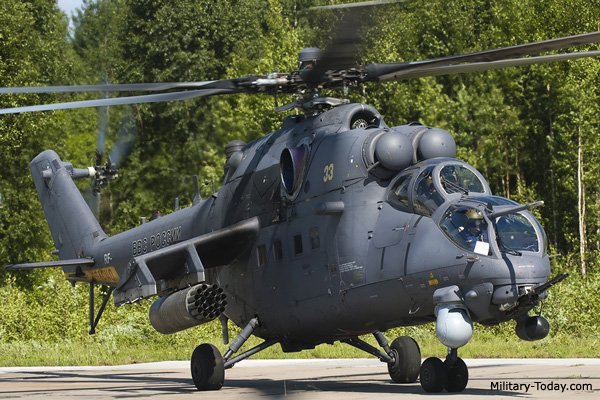Russian envoy to Pakistan Alexey Dedov on Wednesday said that the MI-35 helicopter deal with Moscow and Islamabad is “politically approved”.
In an interview with Radio Pakistan, Dedov said that the Russian Defence Minister Sergey Shoygu will visit Islamabad soon. The report further stated that Alexey Dedov said the deal between Pakistan and Russia will help combat terrorism.
While Dedov said the deal has been “politically approved”, further negotiations on details of the political-commercial contract are in progress.
The ambassador also said that Russian Defence Minister Sergey Shoygu has talks with Pakistani counterparts on his agenda, to discuss the sale of defence equipment to Pakistan.
Pakistan’s request for MI-35 helicopters has been on the table since 2009, but Russia had kept the issue pending because of the Indian factor.
India had long been Russia’s ‘exclusive military technical cooperation partner’. However, Moscow has reportedly downgraded that status to ‘preferred partner’ after India diversified its defence procurements and increasingly began relying on Western sources for meeting its hardware requirements. Russia has, meanwhile, reviewed its policy of selling military equipment to Pakistan.
Ambassador Dedov, however, had earlier maintained that there was no ban on selling defence equipment to Pakistan.
MI-35 helicopters are multi-purpose military transport helicopters which can be used for combat missions.
The Pakistan government has been saying that it genuinely needed these helicopters for counter-terrorism operations.
Mi-35 Helicopters Specifications
The famous Mi-24 helicopters (NATO designation Hind) saw action in many hot spots, local wars, armed conflicts and special operations all around the world. Despite its age the Mi-24 helicopters remains in service with at least 50 air arms.
The Mi-24 helicopter made its name for being easy and cheap to maintain. This helicopter also proved to be reliable. However refurbishment, upgrades and modernization is necessary in order to keep these ageing gunships operational. Especially its electronics needs to be improved to meet modern demands and competitiveness in modern warfare.
Upgraded Mi-35M (NATO Designation Hind-E) was first revealed in 1999. It is an export version of the Mi-24VM. This helicopter is intended only for export. The Mil Helicopter Plant introduced a more modern Mi-28 Helicopters back in 1990s. However many countries, including Russia, can not replace their ageing fleet of Mi-24 attack helicopters due to funding problems. So refurbishment and production of helicopters such as the Mi-35M continues.
Production of the Mi-35M commenced in 2005. This attack helicopter and it’s derivatives are in service with Azerbaijan (24), Brazil (12), Venezuela (8) and possibly some other countries.
The main role of MI-35 helicopter is destruction of armored vehicles, enemy troops, UAVs and other helicopters. It’s secondary role is delivery of troops and special cargo, evacuation of wounded. It can operate at night and in adverse weather conditions.
MI-35 Helicopter Design improvements
The Mi-35 helicopter has a number of improvements. It differs from the basic model by main rotor system of the Mi-28 and X-shape tail rotor. Main rotor’s fiberglass blades have new aerodynamic profile. These are lighter but stronger due to titanium details. Helicopter also has upgraded turboshaft engines. Flight performance such as altitude and maneuverability improved due to these changes. Stub wings were shortened in order to reduce weight. Wings have a number of hard-points for weapons and other uses.
MI-35 Helicopter Electronics improvements
Electronic core of the helicopter underwent fundamental modifications. A whole spectrum of new electronic systems were adopted in the cockpit. The Mi-35M is fitted with upgraded avionics and improved sensor package, including night vision system. Helicopter is also fitted with electro-optical rangefinder/targeting system with thermal imaging guidance channel, satellite positioning and navigation system, electronic multi-function displays, on-board computer and new generation jam-proof communications equipment.
MI-35 Helicopter Weapons
This attack helicopter can carry different weapons, including podded guns, 8 Ataka-V or Shturm-V ant-tank missiles and Igla air-to-air missiles, unguided rockets or bombs. Armament depends on customer requirements. A nose turret carries a GSh-231 23-mm two-barrel cannon. The cockpit and vital components of this helicopter are significantly armored.
MI-35 Helicopter Payload
The Mi-35M has a payload capacity of a whooping 2 400 kg. It can carry a full infantry squad of 8 fully-equipped troops. This feature makes this helicopter unique comparing with Western attack helicopters. A large-caliber machine gun, as well as general purpose machine guns can be installed in the cargo cabin.
Landing gear of the Mi-35M is no longer retractable. This reduced overall weight of the helicopter. Also in case of the crash the landing gear absorbs some of the energy.
It is worth mentioning that other countries also offer their refurbished and upgraded versions of the Mi-24 Hind with modern avionics, weapons, engines and night operation capability. South African company Advanced Technologies and Engineering (ATE) proposes its Superhind upgrade programme. It is estimated that 1 500 Hinds remain in service so market for upgrades remain substantial.
MI-35 Helicopter Variants
Mi-35M1 baseline night attack version.
Mi-35M2 updated version for the Venezuelan army. It is fitted with VK-2500 engines for high-altitude operations.
Mi-35M3 version with updated avionics. It has improved night-time operation capability. Weapons of this gunship include Ataka, Shturm, Igla-V missiles. There is also a 23-mm cannon. A number of changes were made to increase life-cycle and simplify maintenance.
Mi-35M4, also known as AH-2 Sabre. It is an updated version with Israeli avionics for Brazilian Air Force.
| Entered service | 2010 |
| Crew | 2 men |
| Troops | 8 men |
| Dimensions and weight | |
| Length | 17 m |
| Main rotor diameter | 17 m |
| Height | 6.5 m |
| Weight (empty) | ~ 8 t |
| Weight (maximum take off) | 11.5 t |
| Engines and performance | |
| Engines | 2 x GTD TV3-117VMA turboshafts |
| Engine power | 2 x 2 200 hp |
| Maximum speed | 310 km/h |
| Service ceiling | 5.7 km |
| Range | 435 km |
| Ferry range | 1 000 km |
| Armament | |
| Cannon | two-barrel 23-mm cannon |
| Missiles | Ataka-V or Shturm-V anti-tank missiles or Igla air-to-air missiles |
| Other | 57-mm, 80-mm, 130-mm or 240-mm rockets |
Ref : Dawn Military-Today



